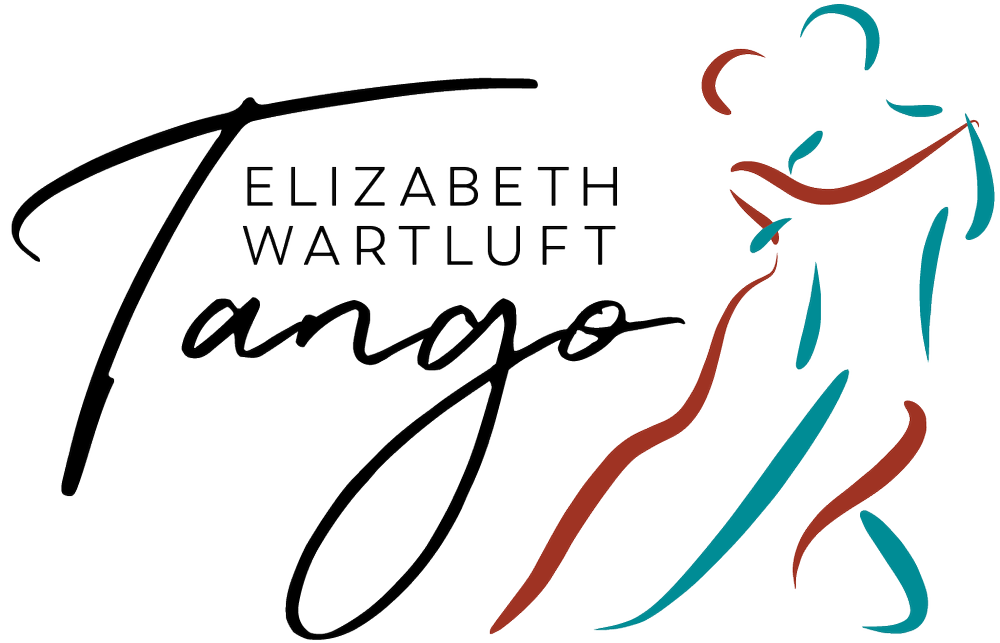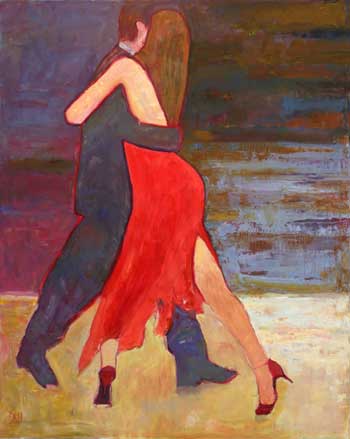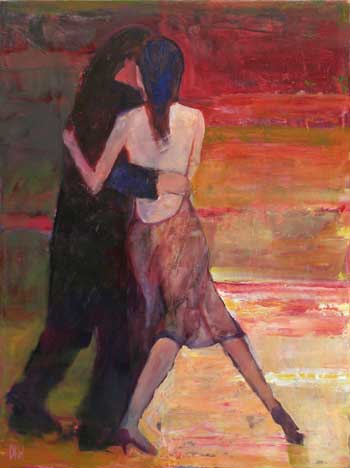If I am touching someone else I will be able to feel theirtextures, the forces moving within them, instead of just the pressure
of my own tight-held fingers indenting their skin. Something is
exchanged through our nerve endings and we are both moved by each
other. Each one of us experiences a slight re-arrangement of all our
cells. (Dowd, p. 45)
Yet another great Irene Dowd article from the book Taking Root to Fly, "The Upper Extremity" discusses the anatomy of the shoulder girdle and arms, provides a good visualization exercise that I think will help in tango embrace (and any partner dancing) and ponders posture and perceived morality, which we'll also address.
First, let's look at how the shoulder girdle is constructed, how that requires us to move efficiently, and what that means in terms of the tango embrace and leading/following a move.
Arm and shoulder anatomy
The shoulder girdle is an incomplete bony ring that rests on top of the ribcage. There are four movable parts: two clavicles (collarbones) and two scapulae (shoulder blades). The only bony connection between the shoulder girdle and the rest of the body, is the joint between the collar bone and and the sternum (breastbone).
The arms attach to the shoulder blades with a ball-and-socket joint at the shoulder. This joint has the most mobility of any joint on the human skeleton. Because of that joint, and because the shoulder blade can move up and down through a large range of motion, your hands can reach anywhere in a three-foot range of the body.
Your elbows have a 180-degree mobility. At the wrist the two bones that make up your forearm can rotate around each other so that the hand surface can face any direction without changing the orientation of the body as a whole. The twenty-seven bones in each hand move around easily as well.
Balance, dynamism and energy
So, the good news: the human shoulder and arm have
enormous mobility potential. The bad news: there are lots of little
tiny pieces that need to be aligned in order to correctly create a good
dance embrace!
Somewhere between extremes, there is a perfect alignment and balance that we can reach, although Dowd notes that it is "not easily achieved" (p. 40). One reason why it is not easily achieved, is that balance must have an element of energy in order to work. If the alignment is perfect, but not movable, then it cannot be used. Below, there is a visualization to practice, in order to find alignment AND energy.
A second reason why we find balance difficult to achieve, is that we don't typically use the entire range of motion that our arms can perform, and thus find it difficult to find middle ground. Most of us use the muscles for keeping our arms and hands in front or above us. Right now, I'm typing and sitting. I do many tasks that require my arms to be in front of me. When my son drags me onto the monkey bars at the playground, I realize how weak my muscles are for hanging or for pulling myself through space from rung to run. Likewise, my pushup muscles are pathetic.
How do we increase our mobility to find a balanced alignment? Relaxing the shoulders and letting them drape over our ribs will help with this mobility. Dowd says we need to ". . . give up all extraneous muscle tension" (p. 43), in order to find an energized, balanced alignment of the shoulder girdle. Try the visualization described below to help achieve that.
Moral judgments, personality traits, and movement
A third reason why balance is elusive is the moral judgments we have been taught to make about various movements through our cultural upbringing or family belief system. Dowd writes:
Since the potential range of motion of the upper extremity is tremendous, no one culture encourages the use of all this range in 'normal' daily activity. Therefore, the final step [towards balance] involves performing movements one may have never thought of before. Performing activities which are 'abnormal' may bring subtle censure from one's own internal, and perhaps uncompromising, moral judge. The censure may be in the form of feeling awkward or just uncomfortable with the unusual movements, or even a little sad or irritated. (Dowd, p. 41)
As humans, we use a lot of arm and hand movement when we communicate (hand waves, shoulders shrugging, arms folded across our bodies, etc.). We cannot move our upper extremities without expressing emotion or communicating information. We react to how we move, and so do other people.
If certain ways of holding the body or moving are not considered morally "right," we fight with our feelings towards that position. Dowd notes: "If one extreme is judged 'good' and the opposite 'bad' then one can hardly feel balanced halfway between these two. Instead one will keep edging towards the 'good' polarity (p. 41)."
Think about the shoulder element of "stand up straight!" that we see here in our culture. The military "upright" stance throws the shoulders back in an extreme position, squeezing the shoulder blades together, pushing the ribs out of alignment and tightening the body. However, this is taught as a "good" position. Conversely, relaxing the shoulders and back to the other extreme creates a slouchy position that is seen as "lazy" or "bad" in our culture. Most students I have taught tend towards the tight extreme and fight relaxing; not surprising in our "look busy" culture. It's a physical expression of our cultural teachings.
What does this say about people wanting a lot of arm motion but not chest motion? A lot of issues with the embrace have to do with how we feel we need to express ourselves to be heard. Moving arms more than balance allows: assuming that the other person is not listening, or that they won't understand us unless we "yell" with our arms. Rigid shoulders and arms: believing there is a "right position" that we can find and hold so we don't make mistakes.
I could be way out in left field here, but I think there are interesting tidbits about people and movement.
I am thinking especially about a student of mine who LOVES big movements. He doesn't like to be controlled any anyone; he enjoys expressing himself any way he wishes; he likes breaking rules. His arms go everywhere. Dancing with him is always fun, in the same way that rock climbing or carnival rides are fun: fear and excitement mixed; I never know what to expect. His belief system and dance style definitely match: no little tango rules are going to stop him!
My teachers have always told me to "Relax, Ely! Relax!" I am so dedicated to doing things 100% right, that I can't do them 100% right! I have had to learn to use less effort, find out how to stretch while relaxing (tight does not equal stretched!), in order to actually become aligned. My upbringing taught that your vocation should feel hard, like work, not relaxed and fun! Oy.
Visualization for aligning your shoulder girdle without extraneous tension from Dowd
Here is a visualization to improve energy flow, release muscles, and help find alignment and balance. It also aims to release the old teachings we hold in our bodies that no longer serve us because they impede balance.
1. Lie on the floor in a relaxed pose (feet flat on the floor, knees up, back relaxed along the floor, arms either relaxed next to you, resting on your body, or reaching up over your head to release on the floor).
2. Close your eyes.
3. As you breathe, light/energy/electricity/color/you choose, explodes out the solar plexus and then flows along a rib, continuing around to where the rib connects to your spine. Breath again and, each time you breathe, expand the energy circling your body to another rib, until you can see/feel the entire rib cage expanding and flowing like this. (Dowd suggests thinking of the rib as a "horizontal gaseous ring" like Saturn's rings).
4. Now, imagine that your shoulder blades can soften and melt away from your rib cage. Dowd suggests thinking of a "chinese fan with its handle at the base of my thorax [right above your lower back] and its furthermost tips arching open at each of my shoulder joints" (p. 44). I think of having wings like a butterfly, and folding them open, so that the outer edges of my shoulder blades release down and the outer edges of my collarbones do the same thing. The shoulders widen and relax away from the spine.
5. Think of each joint as a gateway that can open to the light. Each gateway widens as you let the feeling move through that joint or bone. When you breathe, light/energy/color flows from your chest cavity, out through the shoulder joint, down through the bones of the arm, through the elbow, through your forearm, through your wrist, through the bones of your hand, and out your palm and fingers. Let the energy release out into the ground.
6. Let the energy flow in through the soles of the feet, up through the foot bones, through the ankles, up to the knees, through the knee joint, up to your pelvis, through your pelvis, up to your spine. Then, repeat step 5 and 6 as many times as you like.
7. As your body releases your joints, you can find a new neutral position, free of old habits and old information about the "right" ways to hold or move the body. When you get up, try to bri
ng the new feelings with you, releasing old judgments.
Ideas to bring onto the tango dance floor (or salsa, or swing or polka!) from this work:
If what comes to me from contact with another person seems undesirable to me at any time, I can simply allow it to continue its movement quickly and unimpeded out of me through the very same pathways from my body to earth that I opened wide during my passive visualization activity. (Dowd, p. 45)
Facing another living organism . . . is almost, but not quite, impossible to do with total neutrality and openness, without any use of previously-learned techniques or defensive contraction, (Dowd, p. 45)
If I am touching someone else I will be able to feel their textures, the forces moving within them, instead of just the pressure of my own tight-held fingers indenting their skin. Something is exchanged through our nerve endings and we are both moved by each other. Each one of us experiences a slight re-arrangement of all our cells. (Dowd, p. 45)
I am so grateful to Irene Dowd for writing these lovely articles. At twenty-five, in graduate school, I didn't completely understand what she was talking about (and wished she would be a bit more succinct). How wonderful to re-read them and find that I've been teaching this information for years, having forgotten from whence it came!



